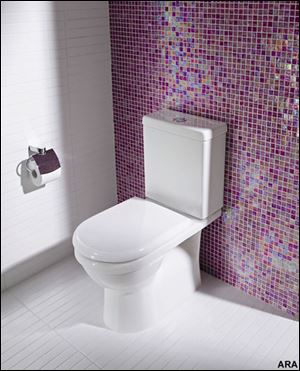
Replace Your Home's Biggest Water Waster
12/4/2008(ARA) - Ready to make your home more environmentally friendly? If you're planning to join the ranks of those who want to do their part for Planet Earth, the bathroom is a good place to start.
According to the Environmental Protection Agency (EPA), toilets, showers and faucets combined represent two-thirds of all indoor water use, with toilets being the biggest water guzzler of all.
Dion Wilson, manager of Waterhouse Bath and Kitchen Studio in Perrysburg, says, Currently, some American households use up to 400 gallons a day. High efficiency toilets are the big thing, especially with the green movement that is going on in the United States.
It's a good time to replace older models with the new efficient ones. Here are five things to keep in mind as you shop for a new one:
1. Educate yourself on High Efficiency Toilets (HETs).
A HET is defined as a fixture that uses 20 percent less water than the 1.6 gallons per flush (gpf) requirement set by the government. Though still voluntary, HETs are becoming a significant part of the marketplace as manufacturers recognize the compelling need for water conservation and water authorities incorporate them into their toilet replacement programs. You'll save the most water with an HET.

The EPA s new WaterSense labeling program guides consumers to the most water efficient products.
2. Consider dual flush technology.
A dual-flush toilet offers two different flush volumes: a little flush and a big flush. Popular in Europe and Asia, and even mandated in Australia, dual flush toilets are increasingly recognized for their common sense approach to water conservation as well as their effectiveness. While many manufacturers offer them, none has more than Caroma, the Australian company that invented the technology 25 years ago, with 30 models now available.
A family of four can save 13,000 gallons of water per year by using a dual-flush toilet instead of a single flush model installed after 1994, and 52,000 gallons of water compared to the older toilets that still exist in many homes. If every home replaced their single flush toilets with dual flush ones, 3.9 trillion gallons of water per year could be saved.
Mr. Wilson notes that dual flush doesn t mean that the toilet must be flushed twice. Unlike older toilets with a single lever, the dual flush toilets have two small buttons one for a smaller flush, and another when more power is required.
Other HETs are 1.28 gallon, and even as low as one gallon.
They are engineered to work as well as the old 3.5 toilets, he says. They ve increased the size of the flush valves for a larger head of pressure with a lower volume of water.
3. Look for the Water Sense Label.
The EPA's new labeling program, called WaterSense, guides consumers to the most water efficient products. Only HETs qualify for WaterSense; and only those certified in independent laboratory testing to meet rigorous criteria for both performance and water efficiency are awarded the label.
4. Choose an easy installation solution.
Select a new toilet that will cover the footprint of your old unit to avoid the need to replace or repair the floor.
5. Check for replacement programs.
Many local water authorities offer significant rebates, sometimes even free toilets, to customers who trade in their old toilets for more environmentally friendly models. Check your local water authority Web site.
In addition to replacing an older toilet with a newer, more efficient one, other environmentally friendly improvements you can make in the bathroom include switching to a low flow showerhead, which according to the EPA will save 18,250 gallons of water a year; and switching out standard aerators for reduce-flow ones. You should also check your faucets for leaks.
Just one drippy faucet can waste up to 13 gallons each day. And you might not even hear it draining your wallet until it's too late. The best way to catch sneaky leaks is to check your water meter. Make sure all the water is off in the house, then look at the meter to make sure the needle isn't moving. Courtesy of ARAcontent